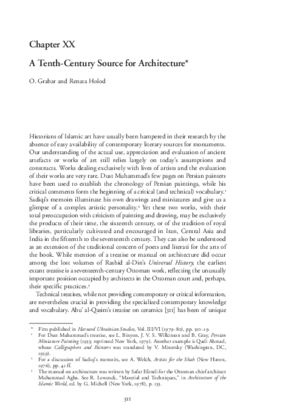
Historians of Islamic art have usually been hampered in their research by the absence of easy availability of contemporary literary sources for monuments. While mention of a treatise or manual on architecture did occur among the lost volumes of Rashid al-Din’s Universal History, the earliest extant treatise is a seventeenth-century Ottoman work, reflecting the unusually important position occupied by architects in the Ottoman court and, perhaps, their specific practices. Abu’ al-Qasim’s treatise on ceramics has been of unique importance in all discussions of Persian pottery of the thirteenth century. Al-Kashi’s fifteenth-century treatise on arithmetic provides instructions for the measurement and computation of surfaces of arches, domes and stalactites, thereby revealing the sophisticated theoretical background on which Timurid architecture, with its precise modular system and its series of structural innovation, could have drawn. Studies on Iranian and Central Asian architecture have been concerned largely with brick building and vaulting techniques and have neglected the important role played by wood.
Grabar, Oleg, and Renata Holod. “A tenth-century source for architecture.” In Early Islamic Art, 650–1100, pp. 311-320. Routledge, 2023.
I agree to the terms outlined below:
You agree to upload and assign Mosqpedia Database the rights to use the content worldwide and in perpetuity across all current and future media platforms. Mosqpedia Database may edit, copy, adapt and translate your contribution.
The content will be distributed under the Creative Commons Attribution-Deed – Attribution-NonCommercial-NoDerivatives 4.0 International – Creative Commons
All data will be stored in line with data protection regulations.